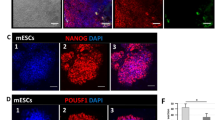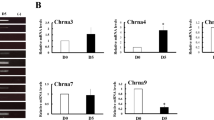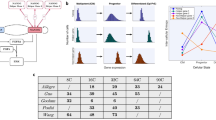Abstract
Nanog is a recently discovered homeodomain transcription factor that sustains the pluripotency of embryonic stem (ES) cells and blocks their differentiation into endoderm. The murine F9 embryonal carcinoma cell line is a well-documented model system for endoderm cell lineage differentiation. Here, we examined the function of Nanog in F9 cell endoderm differentiation. Over-expression of Nanog returns the F9 cells to the early status of ES cells and represses the differentiation of primitive endoderm and parietal endoderm in F9 cells, whereas it has no effect on the differentiation of visceral endoderm. In contrast, the expression of C-terminal domain-truncated Nanog spontaneously promotes endoderm differentiation in F9 cells. These data suggest that Nanog is required to sustain the proper undifferentiated status of F9 cells, and the C-terminal domain of Nanog transduces the most effects in repressing primitive endoderm and parietal endoderm differentiation in F9 cells.
Similar content being viewed by others
Log in or create a free account to read this content
Gain free access to this article, as well as selected content from this journal and more on nature.com
or
References
Strickland S, Mahdavi V . The induction of differentiation in teratocarcinoma stem cells by retinoic acid. Cell 1978; 15:393–403.
Strickland S, Smith KK, Marotti KR . Hormonal induction of differentiation in teratocarcinoma stem cells: generation of parietal endoderm by retinoic acid and dibutyryl cAMP. Cell 1980; 21:347–355.
Kemler R, Brulet P, Schnebelen MT, Gaillard J, Jacob F . Reactivity of monoclonal antibodies against intermediate filament proteins during embryonic development. J Embryol Exp Morphol 1981; 64:45–60.
Morita T, Tondella ML, Takemoto Y, et al. Nucleotide sequence of mouse EndoA cytokeratin cDNA reveals polypeptide characteristics of the type-II keratin subfamily. Gene 1988; 68:109–117.
Weiler-Guettler H, Aird WC, Rayburn H, Husain M, Rosenberg RD . Developmentally regulated gene expression of thrombomodulin in postimplantation mouse embryos. Development 1996; 122:2271–2281.
Dziadek M, Adamson ED . Localization and synthesis of alphafetoprotein in post-implantation mouse embryos. J Embryol Exp Morphol 1978; 43:289–313.
Chambers I, Colby D, Robertson M, et al. Functional expression cloning of Nanog, a pluripotency sustaining factor in embryonic stem cells. Cell 2003; 113:643–655.
Mitsui K, Tokuzawa Y, Itoh H, et al. The homeoprotein Nanog is required for maintenance of pluripotency in mouse epiblast and ES cells. Cell 2003; 113:631–642.
Hart AH, Hartley L, Ibrahim M, Robb L . Identification, cloning and expression analysis of the pluripotency promoting Nanog genes in mouse and human. Dev Dyn 2004; 230:187–198.
Yamaguchi S, Kimura H, Tada M, Nakatsuji N, Tada T . Nanog expression in mouse germ cell development. Gene Expr Patterns 2005; 5:639–646.
Hamazaki T, Oka M, Yamanaka S, Terada N . Aggregation of embryonic stem cells induces Nanog repression and primitive endoderm differentiation. J Cell Sci 2004; 117:5681–686.
Yoshida-Koide U, Matsuda T, Saikawa K, et al. Involvement of Ras in extraembryonic endoderm differentiation of embryonic stem cells. Biochem Biophys Res Commun 2004; 313:475–481.
Niwa H, Masui S, Chambers I, Smith AG, Miyazaki J . Phenotypic complementation stablishes requirements for specific POU domain and generic transactivation function of Oct-3/4 in embryonic stem cells. Mol Cell Biol 2002; 22:1526–1536.
Pan G, Pei D . The stem cell pluripotency factor NANOG activates transcription with two unusually potent subdomains at its C terminus. J Biol Chem 2005; 280:1401–1407.
Pan G, Pei D . Identification of two distinct transactivation domains in the pluripotency sustaining Factor Nanog. Cell Res 2003; 13:499–502.
Veltmaat JM, Orelio CC, Ward-Van Oostwaard D, et al. Snail is an immediate early target gene of parathyroid hormone related peptide signaling in parietal endoderm formation. Int J Dev Biol 2000; 44:297–307.
Chung S, Andersson T, Sonntag KC, et al. Analysis of different promoter systems for efficient transgene expression in mouse embryonic stem cell lines. Stem Cells 2002; 20:139–145.
Fujikura J, Yamato E, Yonemura S, et al. Differentiation of embryonic stem cells is induced by GATA factors. Genes Dev 2002; 16:784–789.
Du ZW, Cong XQ, Yao Z . Forced expression of the Oct-4 gene influences differentiation of embryonic stem cells. Chinese Sci Bull 2001; 46:1446–1449.
Soprano DR, Soprano KJ, Wyatt ML, Goodman DS . Induction of the expression of retinol-binding protein and transthyretin in F9 embryonal carcinoma cells differentiated to embryoid bodies. J Biol Chem 1988; 263:17897–17900.
Hogan B, Beddington R, Costantini F, Lacy E . Manipulating the Mouse Embryo: A Laboratory Manual. 2nd Edition. New York: Cold Spring Harbour Laboratory Press, 1994.
Hyslop LA, Stojkovic M, Armstrong L, et al. Downregulation of Nanog induces differentiation of human embryonic stem cells to extraembryonic lineages. Stem Cells 2005; 23:1035–1043.
Zhang JY, Wang X, Chen B, et al. Expression of Nanog gene promotes NIH3T3 cell proliferation. Biochem Biophys Res Commun 2005; 338:1098–1102.
Niwa H, Miyazaki J, Smith AG . Quantitative expression of Oct-3/4 defines differentiation, dedifferentiation or self-renewal of ES cells. Nat Genet 2000; 24:372–376.
Kumar RM, Murray HL, Jenner RG, et al. Core transcriptional regulatory circuitry in human embryonic stem cells. Cell 2005; 122:947–956.
Constantinescu S . Stemness, fusion and renewal of hematopoietic and embryonic stem cells. J Cell Mol Med 2003; 7:103–112.
Chambers I, Smith AG . Self-renewal of teratocarcinoma and embryonic stem cells. Oncogene 2004; 23:7150–160.
Acknowledgements
We are grateful to Sangmi Chung for the pCBA-hrGFP expression plasmid and Jun Wei for helpful discussion. We also thank Mrs Xiu-Lan Li in our lab for her technical supports.
Author information
Authors and Affiliations
Corresponding author
Rights and permissions
About this article
Cite this article
Chen, Y., Du, Z. & Yao, Z. Roles of the Nanog protein in murine F9 embryonal carcinoma cells and their endoderm-differentiated counterparts. Cell Res 16, 641–650 (2006). https://doi.org/10.1038/sj.cr.7310067
Received:
Revised:
Accepted:
Published:
Issue date:
DOI: https://doi.org/10.1038/sj.cr.7310067
Keywords
This article is cited by
-
Loss of Dead end1 induces testicular teratomas from primordial germ cells that failed to undergo sexual differentiation in embryonic testes
Scientific Reports (2023)
-
An integrated genome-wide multi-omics analysis of gene expression dynamics in the preimplantation mouse embryo
Scientific Reports (2019)
-
The phosphoinositide-3-kinase/Akt pathway mediates the transient increase in Nanog expression during differentiation of F9 cells
Archives of Pharmacal Research (2010)



